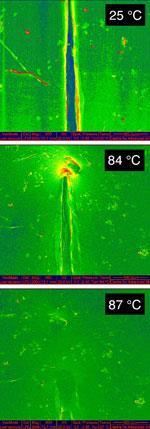New polymer system based on weak, reversible bonds can heal itself when heated
A polymer system based on weak, reversible bonds that can heal itself when heated has been created by UK and US chemists. The new polymers could be further developed and used in the aerospace and other industries, say the researchers.
The team designed a polymeric structure which holds together using aromatic electronic interactions and can easily repair damage to itself when heated to a modest temperature. Previous self-healing polymers have relied on stronger interactions and often require additives to facilitate the healing process.
Researcher Wayne Hayes from the University of Reading says that the project was ’a deliberate effort to design polymers which behave in this way, with reversible assembly characteristics.’

The system uses two polymers, one larger than the other. The larger polymer naturally folds itself up to maximise attractive interactions, leaving tweezer-shaped electron-deficient receptor units. A smaller, linear polymer with an aromatic end group inserts into the folds of the larger polymer, forming interactions known as π–π stacking. ’The faces of the aromatic components stack together to form relatively weakly bonded systems, but if you introduce enough of them overall you build up a significant interaction,’ says fellow Reading researcher, Howard Colquhoun.
At room temperature, the polymer mix forms a flexible, self-supporting material. When the temperature is raised, the interactions holding the structure together are weakened, which allows the polymers to flow into the damaged area.
In one experiment, the team found that a broken film could be re-healed by simply pressing the broken ends gently together and heating briefly at 80°C.
The team suspect the smaller polymer acts as a plasticiser or solvent for the larger polymer, allowing the mix to flow as a liquid. ’We are trying to achieve something that behaves a little bit like a metal - when it melts it flows very easily,’ says Colquhoun.
When the mix is cooled the interactions reform and the original appearance and strength of the material is regained, a change that can be seen by observing the colour of the material, says Colquhoun. At room temperature the material has a blood red colour as a result of the aromatic stacking. The colour is lost when the material is heated to 60 - 65°C, indicating the material has a lower viscosity. When cooled, the red colour returns.
Terence Cosgrove, from the colloid group at the University of Bristol, was impressed with the novelty of the approach, saying that it is ’an intriguing prospect’ to use π–π stacking in this way.
Meanwhile, Colquhoun says the group will continue to develop these materials, aiming to increase the density of the π–π stacking to increase the material’s strength, and perhaps adding additional non-covalent forces other than π stacking. ’Though we are nowhere near the mechanical properties of conventional materials of, for example, carbon fibre composites, we see this material as a starting point,’ he says.
Tom Bond
References
Chem. Commun., 2009, DOI: 10.1039/b910648k






No comments yet